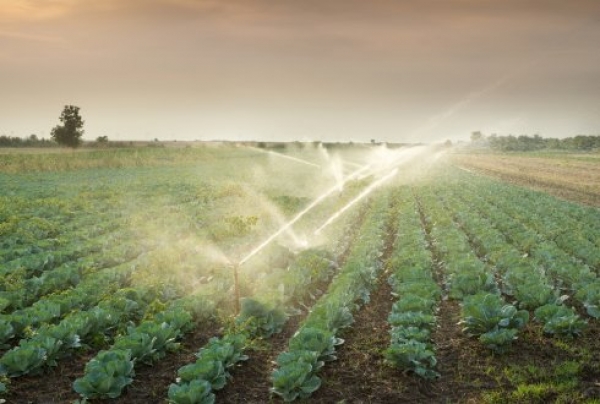Wastewater reuse: benefits beyond food production

By Luca di Mario and Pay Drechsel
This blog is part of the Agriculture and Ecosystems Blog’s month-long series on Ecosystem Services.
Can you name a highly populated place facing tough natural challenges to ecosystem services? We would say Cairo and Lima, two of the largest cities in the world located in a desert. What better places to focus on in a water research institute?
In Lima, with only 13 mm of rain over the year (about half of what Cairo gets), every drop counts. And so does the reuse of water, be it from rain, wells or the Rimac River, which passes the city. There are many reuse activities, formal and informal; while untreated wastewater is, for example, used informally for vegetable farming at scale, formal reuse of treated wastewater remains limited by law to parks and gardens (a common paradox).
Treated wastewater creates a recreational oasis
However, in a city of dust and sand, these parks can change lives. Take Park Huascar, for example; a multi-purpose park with a big lake offering educational parcours, a small zoo, recreational areas, a tree nursery, demonstration farms, playgrounds, a soccer field, and picnic areas under shady trees. A beautiful green island in a dry urban landscape, and an oasis with replication value the city is proud of.
The park receives its water from one of Lima’s 15 wastewater treatment plants. The treated wastewater is free because the treatment plant and the park are on public grounds. In a landscape where most kids grow up without trees, the social benefit of wastewater reuse for creating green space appears immense.
Win-win
The Huascar case of combining wastewater treatment and a public park is in fact a classic win-win situation of reuse: it reduces pollution and optimizes resource recovery and consumption in an urban area. This has important benefits for ecosystems and the services they provide to people (see diagram below).
The treated wastewater supplies important resources to the park such as water and nutrients, which are extremely valuable where soils are ‘dry’ and ‘unfertile’ such as in Lima. As a consequence, the park does not need to irrigated water from the tap, saving freshwater for other uses and replacing important elements/nutrients into soils. With treated wastewater, plants and flowers can grow in the park, creating a recreational ‘oasis’ in the middle of the Peruvian capital, one of the cities with least green space per capita in the world.
Two important local ecosystem services (ESS) are directly enhanced through wastewater use:
- Recreational, mental and physical health of citizens, as the park green area provides an important space for physical and mental relaxation and recreation for both adults and children;
- Erosion prevention and maintenance of soil quality, as the nutrients and the organic matter in the wastewater enhance soil structure, fertility and microbiological activity. This is an important contribution to long-term soil sustainability, particularly in areas prone to land degradation.
Wastewater irrigation in the park also promotes carbon sinking over the mid-to-long term, given the increase in soil organic matter and vegetation. This means that carbon is sequestered in soils and trees, offsetting of greenhouse gas emissions and enhancing the carbon sequestration and the local and global climate regulation ESS.
Risks such as heavy metals and salts accumulation in soils are not known, largely as the treatment plant only serves residential (and not industrial) districts, and cases of pathogen contamination are not reported. This indicates that the wastewater and its reuse are safe.
Hence, wastewater irrigation in Huascar does not cause any negative trade-offs. Instead, it creates synergies amongst different ESS, highlighting the fact that resource recovery and reuse (RRR), when properly designed and managed, is a win-win solution for urban citizens, urban ecosystems, and wastewater management. Wastewater irrigation can also be scaled up.
Reuse and sustainable intensification
In his initial blog post, CGIAR Research Program on Water, Land and Ecosystems (WLE) Director Andrew Noble suggested three thematic areas for the program:
- Sound and efficient resource use,
- Restoring land productivity, and
- Reducing risk and uncertainty.
Without question, avoiding resource loss by recovering and reusing water and nutrients will contribute to efficient resource use, help restore land productivity and increase the resilience of systems against risks, like spiking fertilizer prices. Resource recovery and reuse (RRR), one of four research areas of WLE, supports ecosystem services beyond agricultural production.
The ecosystem services provided by wastewater reuse, if well managed, represents an important opportunity for costs savings. The social benefits that the park creates probably offsets its operational costs by far.
Some of the key research questions we are trying to address in RRR:
- Can a set of key indicators or proxies be identified to quantify and better manage the various linkages/ dependencies between RRR and ESS?
- How to value the social benefits of ESS? For example, compared to wastewater treatment costs and park maintenance, what is the best way to assess the overall costs and benefits of welfare-oriented RRR business models?
Lima is one of nine focus cities that the CGIAR Research Program on Water, Land and Ecosystems (WLE) strategic research portfolio on Resource Recovery and Reuse (RRR) is targeting for testing the feasibility of reuse business models. The Huascar Park is only an example among several that the larger Lima region offers.
Diagram source: Authors, adapted from the Millennium Ecosystems Assessment report (icons by Jan Sasse; www.teebweb.org)
About the Authors:
Luca di Mario is part of the Resource Recovery and Reuse Team with the CGIAR Research Program on Water, Land and Ecosystems (WLE). Pay Drechsel leads the Strategic Research Program on Resource Recovery and Reuse within WLE and is theme leader of Water Quality, Health and Environment at the International Water Management Institute.

Facebook comments